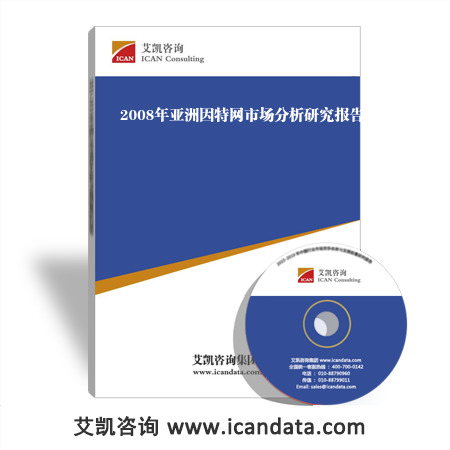数据来源与研究方法:
- 对行业内相关的专家、厂商、渠道商、业务(销售)人员及客户进行访谈,获取最新的一手市场资料;
- 艾凯咨询集团对长期监测采集的数据资料;
- 行业协会、国家统计局、海关总署、国家发改委、工商总局等政府部门和官方机构的数据与资料;
- 行业公开信息;
- 行业企业及上、下游企业的季报、年报和其它公开信息;
- 各类中英文期刊数据库、图书馆、科研院所、高等院校的文献资料;
- 行业资深专家公开发表的观点;
- 对行业的重要数据指标进行连续性对比,反映行业发展趋势;
- 通过专家咨询、小组讨论、桌面研究等方法对核心数据和观点进行反复论证。
报告简介:

摘要
This market report provides a comprehensive overview of the Internet segment of the market across the various economies of Asia. The overview includes Internet statistics on each country.
While there is considerable activity in the Internet and online markets across the region, the market in Asia continues to be dominated by the big players of North Asia, (South Korea, Japan, Hong Kong, etc), with a significant role also being played by some of the South East Asian countries (Singapore, Malaysia, etc). Of course, in terms of sheer Internet user numbers, China (200 million) and India (210 million) maintain a real presence, despite their modest user penetration figures.
In fact as highlighted in the table below, the Asian Internet market can be broken into three user penetration groups. The top group includes the more highly penetrated markets in terms of users and subscribers. They also tend to have sophisticated and extensive broadband access facilities in place. Typically we find that countries from this group are among the global leaders in broadband Internet. South Korea, with a user penetration of over 71%, leads the regional market with a broadband subscriber penetration of 30%. Closely following in second place is Hong Kong with 70% user penetration and 27% broadband subscriber penetration. The countries in this top grouping are characterised by their state of the art national infrastructure and, most importantly, strong regulatory support for expansion of telecom and IT services.
The countries in second band – roughly between 10% and 20% user penetration – are to be found in expansion mode when it comes to their Internet markets. But there is a clear gap (20%) to be bridged before they can be counted in the top grouping. With Thailand (21% user penetration) and Vietnam (20%) playing lead roles in this middle group, we typically find that in the last few years both operators and governments have started to give priority to expanding Internet access and speed in these countries. Of course, as noted already we find China and India in this grouping as the two giants struggle to provide Internet access for their respectively huge populations.
In the third grouping – those markets with a user penetration of less than 10% – we tend to find those countries that, for whatever reason, have not yet ‘got their act together’ when it comes to Internet. Of course, some are performing relatively well under difficult circumstances. Indonesia, for example, has major infrastructure challenges to overcome in providing Internet to its citizens; yet its 9% penetration does in fact represent a very significant 25 million users. And the war-ravaged Afghanistan is managing 2% user penetration under extremely difficult circumstances. Then there is the tiny fledgling nation of Timor Leste (East Timor), which has continued to struggle with political instability as it attempts to build its national infrastructure. At the bottom end of the Internet scale in Asia, however, we find a number of countries that are simply struggling with poor telecom infrastructure and generally underdeveloped regulatory regimes. Included among these are Laos, Nepal, Turkmenistan, Cambodia, Tajikistan, Bangladesh and Myanmar.
目录及图表
1. Afghanistan
1.1 Overview
1.1.1 Internet statistics
1.2 Internet cafés
1.3 Internet Service Providers (ISPs)
1.4 Voice over Internet Protocol (VoIP)
2. Armenia
2.1 Overview
2.1.1 Internet statistics
2.2 Wireless Internet
2.3 ISP market
2.3.1 Arminco Global Telecommunications
2.3.2 Armenian Freenet
2.3.3 Web Ltd (WEB.AM)
2.3.4 Armenian Datacom Company (ADC)
3. Azerbaijan
3.1 Overview
3.1.1 Internet statistics
3.1.2 Computers for schools
3.2 ISP market
4. Bangladesh
4.1 Overview
4.1.1 Internet statistics
4.1.2 Constraints on Internet growth
4.2 MediNet
4.3 Village Computer and Internet Program (VCIP)
4.4 International Internet Gateway (IIG) licence
4.5 ISP market
4.5.1 Overview
4.5.2 BTTB’s ISP service
4.5.3 Grameen Cybernet
4.5.4 Integrated Services Network (ISN)
4.5.5 InTech Online (IOL)
4.5.6 AlwaysOn Network
4.6 Voice over Internet Protocol (VoIP)
5. Bhutan
5.1 Overview
5.1.1 Internet statistics
5.1.2 Government online
5.2 ISP market
5.2.1 DrukNet
5.2.2 Samden Tech
6. Brunei Darussalam
6.1 Overview
6.1.1 Internet statistics
7. Cambodia
7.1 Overview
7.1.1 Internet statistics
7.1.2 Internet access locations
7.1.3 MediaRing’s acquisition of AngkorNet
8. China
8.1 Overview
8.1.1 Internet statistics
8.2 Internet regulations and censorship
8.2.1 Overview
9. Georgia
9.1 Overview
9.1.1 Internet statistics
9.2 ISP market
9.2.1 Georgia Online
9.2.2 SaNet
10. Hong Kong
10.1 Overview
10.1.1 Internet statistics
10.2 Regulatory issues
10.2.1 Regulatory developments
10.3 Internet traffic volume
10.4 Domain names
10.5 Wireless Internet
11. India
11.1 Overview
11.1.1 Growth path
11.1.2 Internet statistics
11.1.3 Growth issues
11.1.4 Service disruption
11.2 Regulatory issues
11.2.1 Internet policy
11.2.2 National Internet Exchange of India (NIXI)
11.2.3 Pricing
11.2.4 Domain names
11.2.5 Censorship and security
11.3 ISP market
11.3.1 Major ISPs
12. Indoensia
12.1 Overview
12.1.1 Internet statistics
12.1.2 Internet information control
12.1.3 Cyber laws
12.1.4 Telkom’s national IP backbone
12.1.5 IPv6
12.2 ISP market
13. Japan
13.1 Overview
13.1.1 Internet statistics
13.2 Internet Initiative Japan (IIJ)
13.3 Japan Internet Providers’ Association (JAIPA)
13.4 Regulatory issues
13.4.1 Policy on national information superhighway
13.4.2 Government’s IT Basic Strategy
13.4.3 Internet replacement
13.5 Fight against Google dominance
13.6 Online banking
14. Kazakhstan
14.1 Overview
14.1.1 Internet statistics
14.1.2 Kazakh Network Information Centre (KazNIC)
14.1.3 Ashyk Alem Project
14.2 ISP market
14.2.1 Kazakhstan Online
14.2.2 Nursat
14.3 Internet Protocol TV (IPTV)
15. Kyrgyzstan
15.1 Overview
15.1.1 Internet statistics
15.2 ISP market
16. Laos
16.1 Overview
16.1.1 Internet statistics
16.2 ISP market
16.3 Public Internet access
16.4 Top level domain name
17. Macau
17.1 Overview
17.1.1 Internet statistics
17.1.2 ISP market
17.1.3 Licensing of Internet services
18. Malaysia
18.1 Overview
18.1.1 Internet statistics
18.2 ISP market
18.2.1 Initial market structure
18.2.2 Restructure of the Internet service market
18.2.3 TMNet
18.2.4 Jaring
18.2.5 Maxis Net
18.2.6 Time dotNet
18.2.7 iZZinet
18.3 Internet via satellite
18.4 National IPv6 Council
19. Maldives
19.1 Overview
19.1.1 Internet statistics
19.2 Competition
19.3 Government Network of the Maldives (GNM)
20. Mongolia
20.1 Overview
20.1.1 Internet statistics
20.2 Mongolia Internet Exchange (MIX)
20.3 ISP market
20.3.1 DataCom (MagicNet)
20.3.2 Other ISPs
21. Myanmar
21.1 Overview
21.1.1 Internet statistics
21.1.2 Internet cafés
21.1.3 WiMAX
22. Nepal
22.1 Overview
22.1.1 Internet statistics
22.1.2 WiFi network for remote villages
22.2 ISP market
23. North Korea
23.1 Overview
23.2 ISP market
23.3 Websites
23.4 Email service
23.5 Voice over Internet Protocol (VoIP)
23.6 Internet cafes
24. Pakistan
24.1 Overview
24.1.1 Internet statistics
24.1.2 Major government initiatives
24.1.3 Internet censorship
24.2 ISP market
25. Philippines
25.1 Overview
25.1.1 Internet statistics
25.2 Internet exchanges
25.2.1 PhIX
25.2.2 I-Gate
25.3 Internet regulations
25.3.1 Commission on Information and Communications Technology (CICT)
25.4 Gearing Up Internet Literacy and Access for Students (GILAS)
25.5 Cybercafés
25.6 ISP market
25.6.1 Selected ISPs
25.6.2 Internet Data Centres (IDCs)
25.7 Internet via satellite
25.8 IP networks
26. Singapore
26.1 Overview
26.1.1 Internet statistics
26.1.2 Singapore Network Information Centre (SGNIC)
26.1.3 Regulatory environment
26.1.4 International Internet infrastructure
26.1.5 Internet data centres
26.1.6 Internet security
26.1.7 International Internet Exchange
26.2 ISP market
26.2.1 Overview of selected ISPs
27. South Korea
27.1 Overview
27.1.1 The world’s most penetrated broadband Internet market
27.1.2 Internet statistics
27.1.3 Internet cafes/PC bangs
27.1.4 Inter usage patterns
27.1.5 Internet search engines
28. Sri Lanka
28.1 Overview
28.1.1 Internet statistics
28.2 Internet exchange
28.3 Public Internet access
28.4 Data centres
28.5 ISP market
28.5.1 Lanka Internet Services
28.5.2 Wishya Online (Pvt) Ltd
28.5.3 ITMIN Ltd
28.5.4 Eureka Online (Pvt) Ltd
28.5.5 Pan Lanka Networking (Pvt) Ltd
28.5.6 Lanka Global Online
28.5.7 SLTNet
28.5.8 Suntel wOw
28.5.9 BellNet
28.6 E-commerce
29. Taiwan
29.1 Overview
29.1.1 Internet statistics
29.2 Public Internet access
29.3 Internet hosts
29.4 Direct Internet access network
29.5 TWGate
29.6 ISP market
29.6.1 HiNet
29.6.2 SeedNet
29.6.3 Eastern Broadband
29.6.4 TrandSend Internet Co
29.6.5 JoinNet
30. Tajikistan
30.1 Overview
30.1.1 Internet statistics
30.2 Censorship
31. Timor Leste
31.1 Overview
31.1.1 Internet statistics
31.2 VoIP
32. Thailand
32.1 Overview
32.1.1 Internet statistics
32.1.2 Thailand proposed as a regional ICT hub
32.1.3 Internet censorship
32.2 ISP market
32.3 Major ISPs
32.3.1 True Internet (formerly Asia Infonet)
32.3.2 CS Loxinfo
32.3.3 Jasmine Internet (Ji-NET)
32.3.4 Internet Thailand Co
32.3.5 KSC Commercial Internet
32.3.6 Loxley Information Services (Loxinfo)
32.3.7 Samart Infonet
32.3.8 Pacific Internet
32.3.9 Roynet Internet
32.3.10 CATNET
32.4 Thailand Internet Exchange (THIX)
32.4.1 Opening up of gateway market
32.5 Regulatory issues
32.5.1 Internet charges
32.6 Internet cafes
32.7 Content
32.8 IT policy
33. Turkmenistan
33.1 Overview
33.1.1 Internet statistics
33.2 Censorship
34. Uzbekistan
34.1 Overview
34.1.1 Internet statistics
34.2 ISP market
35. Vietnam
35.1 Overview
35.1.1 Internet statistics
35.1.2 Internet subscriber projections
35.1.3 International bandwidth
35.2 Regulatory environment
35.2.1 Government control
35.2.2 Proposed Cyber Law
35.3 Vietnam Internet Network Information Center (VNNIC)
35.3.1 Domain name system
35.4 Internet cafés
35.5 ISP market
35.5.1 NetNam
35.5.2 Online service providers
35.5.3 Electricity of Vietnam (EVN)
35.5.4 International leasing charges for IXPs
35.6 Voice over Internet Protocol (VoIP)
35.7 Satellite Internet
35.8 Emerging IT industry
36. Glossary of Abbreviations
亚洲因特网
















